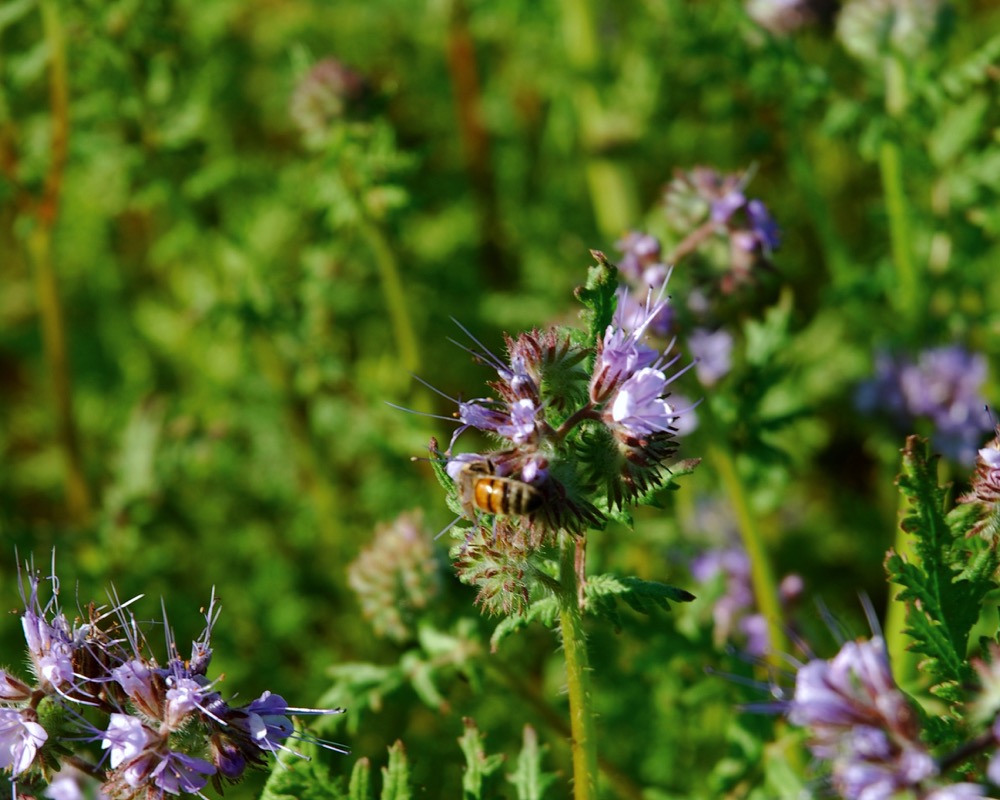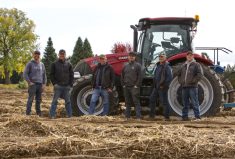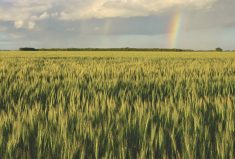Here in early 2015, it’s becoming a recognized pattern in agriculture: another day, another article, another proclamation and another call for action, all revolving around farmers’ use of neonicotinoid seed treatments and the alleged damage this does to bees and bee colonies.
To say there is an abundance of information on this topic is one of the biggest understatements in agriculture today. Arguably, the most challenging task is to sift through the reams of available research and findings, analyzing the current political posturing and recognizing the misinformation that’s funnelled through the mainstream media. That’s also what awaits anyone trying to arrive at a workable solution that will suit modern farming practices while satisfying beekeepers and the general public.
Read Also

Could crop sharing be a viable option for your farm?
Crop sharing could be a good option for young and beginning farmers.
What’s at stake can be frightening. Conversations with members of the seed and chemical sector, researchers and involved stakeholders including beekeepers call up a scenario that some say could conceivably push farmers out of business, or at least backwards by several decades. Claims by industry participants go beyond the notion that Ontario’s environment ministry is targeting neonicotinoids, while the agriculture ministry sits on the sidelines. Now there are rumblings that phosphorus fertilizer, herbicides, fungicides — even transgenics — are in the government’s crosshairs, any of which might render the province’s grains and oilseeds sector little more than an afterthought instead of one of its leading economic engines.
No one in agriculture is arguing there’s no room for improvement: that’s one of the hallmarks of the industry. Yet in spite of repeated pledges by Ontario’s agri-food sector to work collaboratively on finding workable solutions, it’s becoming evident that there is no room for negotiating in what began as a debate and now threatens to become a war. Even with the amount of information that’s available, activism and protectionism have polarized this issue. In many ways, it’s created a greater divide than the introduction of transgenic soybeans and corn, both of which came to market prior to the widespread adoption and subsequent reliance on the Internet and social media.
It turns out, however, that the neonic debate is unscientific from the very bottom. Bee decline isn’t an issue that can be boiled into a singular cause-and-effect relationship. Dr. Cynthia Scott-Dupree, a researcher at the University of Guelph who has studied this issue extensively since 1999, has referred to it as “a 1,000-piece puzzle.”
That’s why it’s exceedingly difficult for media outlets and concerned individuals to provide balance and accuracy in reporting the ongoing struggles of this puzzle: the issue cannot be condensed or distilled down to a 450-word newspaper story or a 90-second sound bite. As with most aspects of the agri-food industry, there’s a lot more to it, and it’s debatable as to whether most people are willing to invest the time and effort to sort through all of the details.
Who’s involved?
As the Ontario Beekeepers Association (OBA) continues to ramp up its campaign against neonicotinoid seed treatments, the list of those advocating for sound science in dealing with the situation continues to grow. In 2013, when the issue of so-called “bee kills” began receiving more press, the seed and chemical companies were the first to respond, warning of conflicts and a potential return to the use of broader-spectrum pesticides. Prior to the growing season that year, government extension personnel and University of Guelph researchers began exploring different measures to reduce the impact of “fugitive dust,” which was identified as a significant threat to bee health.
In the time since, there have been numerous attacks by OBA board members and select beekeepers, and a successful bid to get the Ontario government to enact a policy that would see neonicotinoid seed treatments reduced by 80 per cent by 2017. Since the government’s pledge in late 2014, the Grain Farmers of Ontario (GFO) has been one of the leading opponents of any ban on neonicotinoid seed treatments, with news releases, a cover story in its own publication and in early March 2015, a pollinator health blueprint it has reportedly shared with the government.
Last November, the organization also joined Farm Action Now, a coalition with the Ontario Bean Growers (OBG), Ontario Fruit and Vegetable Growers Association (OFVGA) and Ontario Pork. Joining the list of organizations standing alongside the GFO are the Ontario Soil and Crop Improvement Association (OSCIA), the Ontario Federation of Agriculture (OFA), Canadian Association of Professional Apiculturists (CAPA) and the Canadian Seed Trade Association (CSTA). Statistics Canada, the Conference Board of Canada and the Pest Management Regulatory Agency (PMRA), have also authored reports that counter some of the numbers cited in OBA news releases and on its website. There’s also been additional support provided by CropLife Canada, CropLife America, the National Farmers Union in Britain and other smaller organizations. On an individual basis, Drs. Cynthia Scott-Dupree and Chris Cutler, Alberta beekeeper Lee Townsend — even media pundits such as Terence Corcoran from the National Post and Henry Miller from Forbes — have been speaking out in favour of modern farming and denouncing the abandonment of sound scientific principles.
Departure from ‘sound science’
So the good news is that agriculture is developing a united front in countering the OBA actions. The challenge, however, is that modern agriculture is short on time. And it’s that commodity that agriculture and science need more of with roughly 20 months before the government’s proposed legislation goes into effect.
“Good science takes time,” says Dave Baute, current president of the CSTA. Although he’s pleased with interim reports that have been supportive, he is also frustrated with the lack of political will. “I wish that politicians would place their trust in scientists, not rely on some loose and tainted interpretation of a precautionary principle. The media and the government of Ontario chose to pay attention to very select statements made in papers and studies, and chose to ignore the context in which they were made and the facts presented by Statistics Canada.”
Those particular numbers (Table 1) indicate beekeeping and associated production is on the upswing, not declining as has been the contention of OBA board members. Baute, who is also president of Maizex Seeds near Tilbury, Ont., cites another StatsCan report that indicates bee colony numbers and honey production have risen steadily since 2002 (Table 1).
“The PMRA’s recent update that showed the reduced incidents over the winter of 2014 was also positive,” says Baute. “Partly as a result of the efforts of farmers and the seed industry, the numbers of overwintering incidents reported to the PMRA were down significantly from 2013, and most of the incidents reported came from only three operations.”
In fact, the agency’s report, issued in November 2014, supports the original registration data and notes a 70 per cent reduction in reported bee health incidents during the 2014 planting season, compared to 2013. That, adds Baute, has given some comfort to the agri-food industry to see that decisions are being made using a science-based approach at the federal level. It also provides a confirmation that farmers’ efforts as “stewards of the environment” are effective.
Collaborative effort important
The notion that so many interests in agriculture — from the seed companies to the chemical companies to equipment manufacturers and ag retailers — have worked together to reduce any impact of seed treatments on bee health needs to be underscored. It’s no secret that agriculture is divided and representative of a very small segment of Canadian society (the “less-than two per cent” factor). Yet following the spectre of thousands of bee colonies “being killed” in the spring of 2013 by the use of an insecticidal seed treatment in use for nearly a decade, Bayer CropScience rushed its new fluency agent to market, replacing talc and graphite as a dry lubricant. A French equipment manufacturer also made its deflector kit for negative pressure (vacuum) planters available to a Quebec dealer. And as Baute is quick to acknowledge, farmers do have the option of buying their seed without it being treated.
That option has sparked some concern within the seed and chemical sector, but Dr. Terry Daynard, a former University of Guelph professor, also sees that as a positive. He’s been approached by numerous farmers who have opted out of planting treated seed, only because they’re farming on harder clay soils and not finding the same insect pressure as those on sandier or lighter soils. That sort of scrutiny can only be a good thing, according to Daynard.
“The argument that not every acre of corn in Ontario needs to be treated is legitimate and it’s hard to argue with that,” he says. Daynard spends some of his time attending meetings and conferences, sometimes as a speaker but always as an interested participant. “You can say that it costs you about $6 an acre for treated seed, and you perhaps have an investment of $600 an acre going into growing corn. So from a management standpoint, this is a reasonable insurance cost, and if that’s all you were looking at, that’s a fair thing to do, but if you start looking at the environmental implications, then it’s not a reasonable thing to do. So that’s one that we have to struggle with and figure out how to deal with.”
Above all, Daynard is interested in establishing the truth along with the best course of action. Obeying sound scientific principles is the only way to do that, he says, so he got involved in this issue when the bulk of the information that was coming out in news releases, media reports and general discussions proved too one-sided. When he started doing some fact-checking of his own, including talking to those he knows in horticulture, he found the actual numbers didn’t jibe with the claims of the OBA and its supporters. As he’s learned more, he’s posted blogs on his website and taken to social media to provide balance and accuracy, and counter claims made by the OBA and its cohorts.
Much of the problem Daynard sees comes from the oversimplification of many of the points made by the anti-neonic side. For instance, there’s the belief that if neonicotinoids are banned, it would solve any problems surrounding bee health completely. Yet the exact opposite could occur. Without seed treatments, many growers could revert to using broader-spectrum pesticides that kill all insects, including beneficials such as ladybird beetles.
Varroa mites still a problem
Another misconception from the anti-neonic camp is that disease management is no longer a concern. Daynard insists that is simply not true. When he began studying the different aspects contained in the issue, he was surprised to find that varroa mite infestations are still affecting the beekeeping sector.
“If you don’t manage varroa very carefully, you’re going to have lots of problems in the bee business,” says Daynard. “Dr. Ernesto Guzman, who’s at the University of Guelph, and a group of other bee researchers across Canada published a report a few years ago that varroa is directly responsible for 85 per cent of the bee deaths in Canada. To me, that’s by far the biggest problem that beekeepers have — if you don’t manage varroa properly, you’re just not in business.”
Lee Townsend, a commercial beekeeper from Stony Plain, Alta., echoes that statement. A well-known advocate for beekeepers and agriculture working together, Townsend has also constructed a website in an effort to inform people — and dispel claims made by the OBA’s directors and other supporters. Early in 2015, he posted a five-page dissertation that picked apart a media release from the OBA disputing comments and claims from various agricultural groups and companies. From Townsend’s vantage point, there simply isn’t enough factual information that’s cutting through the rhetoric, including the facts on varroa, which he calls a “gateway pest.”
“If you have a problem with varroa in your operation, it leads you down the road of all the other viruses and diseases that can affect bees,” says Townsend, who has been monitoring the neonic situation since its introduction in Canada. “We do have controls for varroa; the one effective synthetic miticide we have is Apivar (amitraz), which we’ve been using now for six or seven years, and usually it’s around year eight that we start to see resistance buildup. We haven’t seen that yet, but we have no synthetic miticides in the pipeline ready to use if there’s resistance with Apivar.”
Another issue he has is with the reporting of colony health and deaths from the winter of 2013-14 (Table 2). On his albertabuzzing.com website, Townsend, who was once on the pesticide committee with the Canadian Honey Council, says that statistics on overwintering losses in Ontario are overblown. The stats are estimated via a voluntary survey sent out to the province’s 247 registered commercial beekeepers. Out of 247 in 2013-14, only 97 (or 39 per cent) responded — without a definitive statement on how many colonies were involved. And of those 97 producers, 50 (51.5 per cent) reported losses of higher than 50 per cent. Yet these producers that claimed losses of more than 50 per cent represent only 20 per cent of the commercial beekeepers in Ontario. So how OMAFRA arrived at the 58 per cent figure cited in the Canadian Association of Professional Apiculturists’ report is somewhat suspect, from Townsend’s perspective.
What about management?
Townsend maintains there’s a considerable difference between hobbyist beekeepers and those who rely on bee and honey production as a livelihood. In Alberta, he refers to the ties between the commercial beekeepers and the farmers, as well as those in the seed and chemical sector: the retailers and researchers.
“We’ve been dealing with these companies for a very long time, we’ve been exposed to neonics for as long, if not longer, than Ontario — and at a lot higher dosage level just by the acreage of canola that’s grown out here, and by the number of hives — and we haven’t had any problems,” says Townsend. “But we had other issues a number of years ago with hive health and we’ve worked with all of our partners to find out why. Since then we’ve seen nothing but growth, so we learned very quickly that working with the parties involved works much better than annoying them.”
To be clear, Townsend left the Canadian Honey Council’s pesticide committee because of his frustration in dealing with OBA directors, not the members. He stresses that there are some very good beekeepers in Ontario who have tried to distance themselves from the board, often because he finds the directors are fixated on the “one-issue, one-solution” scenario: ban neonics and all will be right in the world.
“When you try to bring up that (multi-faceted) approach with the OBA board of directors, it’s, ‘No, we know what we’re doing — it’s all the neonics,’ and that’s not the truth,” says Townsend, adding that media reports often unveil more information than intended. “Anytime I see the paper or TV reports, they show these beekeepers who are losing their bees and claiming that it’s neonics. But you look at the equipment they’re using and the management practices they’re following, and it’s not a surprise their bees are dying.”
Cause and effect
Management of bee health and the abandonment of sound science are also at the top of the list for Dr. Cynthia Scott-Dupree, who has been studying the effect of neonicotinoid seed treatments on canola. For her, there are two concepts involved with neonics and bees. The first is that of residues in nectar and pollen of flowering plants grown from treated seed (which is part of the work she has done in canola).
“If you look at the Tier Three large-scale field studies done on that — and even the Tier Two tented studies that have been done — you can see, repeatedly, there is virtually no acute impact on honeybees and there appears to be very little chronic or sub-lethal impact,” says Scott-Dupree.
The other part is the issue of contaminated dust that results during the planting of treated seeds with negative pressure or vacuum-type planters. In 2012, when the reports of the first bee kills in Ontario came out, it was a perfect storm of conditions: the winter season was short and very mild, the start of spring was open and advanced and some farmers were planting in late March, in windy and dry conditions.
“Because it was warm the bees were out foraging and there were bee losses,” she says. “The PMRA did its assessment and came up with the figure that 70 per cent of the bees that were dead contained neonics. But there’s a problem with that kind of reference to neonic residues, because they never indicated the amount of those residues — the mere presence of a toxin doesn’t mean that it’s going to kill — it’s the dose that makes the poison.”
This is where Scott-Dupree becomes concerned that the government’s approach is based on politics and emotions — not science. For starters, how did the provincial government arrive at an 80 per cent mark for the reduction of treated seed? On top of that, she questions the demand that growers buy treated seed in October when they can’t predict the severity of winter conditions and how those conditions will have an impact on pest levels the following spring.
“If we had the science that allows farmers to predict whether they will need treated seeds or not — that early before planting — then we’d be in a good place, but we aren’t there,” says Scott-Dupree. “In the end, if we want to come up with an answer that’s going to benefit everyone, there may have to be compromises from a lot of different sides.”
Other considerations
Scott-Dupree believes time will provide several clearer paths to follow. She has studied and participated in work being done by Dr. Art Schaafsma at the University of Guelph’s Ridgetown Campus, and she believes there is a problem with bee exposure to contaminated dust at planting. But finding scientific solutions takes time.
Even the recommendation within the government’s policy — to train certified crop advisers to scout pest levels and make recommendations on the need for seed treatment — will require more time than the policy allows. That’s mostly because there isn’t the long-term data required for training them.
“This is what annoys me about the government in making these decisions,” says Scott-Dupree, whose research has been ignored by the government on one side and routinely attacked by OBA board members on the other. “It all looks good… but they don’t have the science to support these decisions, and they don’t want to listen.”
Scott-Dupree contends that when the beekeepers first stated that neonics were killing their bees, people really didn’t pay much attention to them. But then when they shifted their perspective to say growers were not using the concept of integrated pest management (IPM) correctly — they’re treating with chemicals prophylactically, which is exactly what IPM isn’t — more people started listening, and rightly so.
That also opens the door on a whole new discussion surrounding the use of IPM. The challenge, however, is the confusion surrounding the actual definition of the concept. Like the term “sustainability,” IPM can mean different things to different people. As Scott-Dupree says, the concept of IPM on paper is amazing, but getting people to embrace it fully can be extraordinarily difficult.

Much more at stake
Beyond banning neonicotinoid seed treatments, there is concern that activists will continue their efforts. But if the effects of a neonic ban on rapeseed farmers in the U.K. are any indication, Ontario farmers stand to lose a lot in the short and long term.
Farmers in Britain have endured a ban on neonicotinoid-treated seed for their rapeseed, and in 2014 suffered devastating losses against overwhelming populations of cabbage stem beetles.
But the damage to farmers’ management practices and overall production levels are just two of many facets. Two separate studies, one from the Conference Board of Canada and another from a group of agricultural economists and scientists with AgInfomatics in the U.S., forecast crippling economic impacts in both countries. The Conference Board’s research estimates Ontario farmers would lose more than $630 million annually. That would affect jobs throughout the food value chain, from country elevators and ag retailers to equipment manufacturing and research and development. And it’s likely that it would affect jobs in urban centres, as well. The AgInfomatics research was a little more conclusive and ominous, stating, “Research results prove that neonicotinoids add billions of dollars to the economy and benefits entire communities, not just individual farmers.”
“This is a fight for science-based decision-making on the part of leadership,” says Baute, who is also impressed with how seed, chemical and equipment sectors have worked proactively to find the best course of action. “If the leaders of our government have caved to the political opportunity of popularity, then all bets are off.”


















